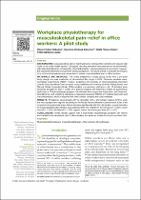Por favor, use este identificador para citar o enlazar este ítem:
https://repositorio.usj.es/handle/123456789/1031
Registro completo de metadatos
| Campo DC | Valor | Lengua/Idioma |
|---|---|---|
| dc.contributor.author | Fortún Rabadán, Rocío | - |
| dc.contributor.author | Jiménez Sánchez, Carolina | - |
| dc.contributor.author | Flores-Yaben, Olatz | - |
| dc.contributor.author | Bellosta-López, Pablo | - |
| dc.date.accessioned | 2024-01-15T12:19:16Z | - |
| dc.date.available | 2024-01-15T12:19:16Z | - |
| dc.date.issued | 2021-02-27 | - |
| dc.identifier.issn | 2319-6440 | en_US |
| dc.identifier.uri | https://repositorio.usj.es/handle/123456789/1031 | - |
| dc.description.abstract | BACKGROUND: Musculoskeletal pain is highly prevalent among office workers and causes high costs to the public health system. Strategies including education and exercise are recommended, with major benefits when conducted by physical therapists in the occupational environment. However, the required investment is uncommon among companies. This study aimed to evaluate the efficacy of a multimodal physiotherapy intervention to relieve musculoskeletal pain in office workers. MATERIALS AND METHODS: The study employed a single group study with a pre‑post study design and was conducted at Universidad San Jorge in 2018. Outcome variables were: workplace ergonomics (INSHT Guide), existence and severity of musculoskeletal disorders (Nordic Musculoskeletal Questionnaire), musculoskeletal pain intensity (Numeric Rating Scale), and Clinical Global Impression Scale. Office workers in a university setting (n = 24, 19 females) were assessed at baseline, after 4 weeks of in‑person sessions and following 3 weeks of autonomous performance. The physiotherapy program included education, ergonomic supervision, self‑treatment, strengthening, and stretching exercises. A repeated‑measures ANOVA or Friedman test (with post hoc comparisons) and Chi‑squared test were used to compare the study variables. RESULTS: At baseline, cervical spine (54%), shoulder (42%), and lumbar regions (37.5%) were the most symptomatic regions according to the Nordic Musculoskeletal Questionnaire. Even if the proportion of symptomatic areas did not decrease significantly after the intervention, a great reduction of musculoskeletal pain intensity was observed after the program in the cervical (P < 0.001), lower back (P = 0.005), shoulder (P = 0.006) regions, and in the overall pain level (P < 0.001). CONCLUSIONS: These results support that a multimodal physiotherapy program can relieve work‑related musculoskeletal pain in office workers and serve as a basis for future controlled trials. | en_US |
| dc.format.extent | 10 p. | en_US |
| dc.format.mimetype | application/pdf | en_US |
| dc.language.iso | eng | en_US |
| dc.publisher | Wolters Kluwer - Medknow | en_US |
| dc.relation.requires | Adobe pdf | en_US |
| dc.rights | Attribution-NonCommercial-NoDerivatives 4.0 Internacional | * |
| dc.rights.uri | http://creativecommons.org/licenses/by-nc-nd/4.0/ | * |
| dc.subject | Musculoskeletal diseases | en_US |
| dc.subject | Musculoskeletal pain | en_US |
| dc.subject | Office workers | en_US |
| dc.subject | Physiotherapy | en_US |
| dc.title | Workplace physiotherapy for musculoskeletal pain‑relief in office workers: A pilot study | en_US |
| dc.type | info:eu-repo/semantics/article | en_US |
| dc.identifier.publicationfirstpage | 1 | en_US |
| dc.identifier.publicationlastpage | 10 | en_US |
| dc.identifier.doi | https://doi.org/10.4103/jehp.jehp_888_20 | en_US |
| dc.rights.accessrights | info:eu-repo/semantics/openAccess | en_US |
| Aparece en las colecciones: | Artículos de revistas | |
Ficheros en este ítem:
| Fichero | Descripción | Tamaño | Formato | |
|---|---|---|---|---|
| Workplace physiotherapy for musculoskeletal pain‑relief in office.pdf | 600,76 kB | Adobe PDF |  Visualizar/Abrir |
Este ítem está sujeto a una licencia Creative Commons Licencia Creative Commons

